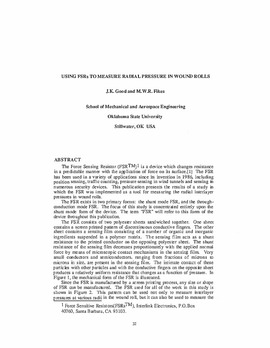| dc.contributor.author | Good, J. K. | |
| dc.contributor.author | Fikes, M. W. R. | |
| dc.contributor.other | International Conference on Web Handling (1991) | |
| dc.date.accessioned | 2019-11-04T18:54:20Z | |
| dc.date.available | 2019-11-04T18:54:20Z | |
| dc.date.issued | 1991-05 | |
| dc.identifier | oksd_icwh_1991_good2 | |
| dc.identifier.citation | Good, J. K., & Fikes, M. W. R. (1991, May). Using FSRs to measure radial pressure in wound rolls. Paper presented at the First International Conference on Web Handling (IWEB), Stillwater, OK. | |
| dc.identifier.uri | https://hdl.handle.net/11244/321655 | |
| dc.description.abstract | The Force Sensing Resistor (FSRTM)1 is a device which changes resistance in a predictable manner with the application of force on its surface.[1] The FSR has been used in a variety of applications since its invention in 1986, including position sensing, traffic counting, pressure sensing in wind tunnels and sensing in numerous security devices. This publication presents the results of a study in which the FSR was implemented as a tool for measuring the radial interlayer pressures in wound rolls. | |
| dc.description.abstract | The FSR exists in two primary forms: the shunt mode FSR, and the through conduction mode FSR. The focus of this study is concentrated entirely upon the shunt mode form of the device. The term "FSR" will refer to this form of the device throughout this publication. | |
| dc.description.abstract | The FSR consists of two polyester sheets sandwiched together. One sheet contains a screen printed pattern of discontinuous conductive fingers. The other sheet contains a sensing film consisting of a number of organic and inorganic ingredients suspended in a polymer matrix. The sensing film acts as a shunt resistance to the printed conductor on the opposing polyester sheet. The shunt resistance of the sensing film decreases proportionately with the applied normal force by means of microscopic contact mechanisms in the sensing film. Very small conductors and semiconductors, ranging from fractions of microns to microns in size, are present in the sensing film. The intimate contact of these particles with other particles and with the conductive fingers on the opposite sheet produces a relatively uniform resistance that changes as a function of pressure. In Figure I, the mechanical form of the FSR is illustrated. | |
| dc.description.abstract | Since the FSR is manufactured by a screen printing process, any size or shape of FSR can be manufactured. The FSR used for all of the work in this study is shown in Figure 2. This pattern can be used not only to measure interlayer pressures at various radii in the wound roll, but it can also be used to measure the pressure variations across the width of the web in the cross machine direction. | |
| dc.description.abstract | This publication will first present a technique by which the FSR can be calibrated for experimental studies of the radial pressure profile in wound rolls. The results of wound roll studies which have led to the discovery of a new boundary condition for wound roll stress models are also presented. The development of this boundary condition allows models previously constrained to center-winding to be applied to center-winding with an undriven nip roll pressed against the wound roll. | |
| dc.format | application/pdf | |
| dc.language | en_US | |
| dc.publisher | Oklahoma State University | |
| dc.rights | In the Oklahoma State University Library's institutional repository this paper is made available through the open access principles and the terms of agreement/consent between the author(s) and the publisher. The permission policy on the use, reproduction or distribution of the article falls under fair use for educational, scholarship, and research purposes. Contact Digital Resources and Discovery Services at lib-dls@okstate.edu or 405-744-9161 for further information. | |
| dc.title | Using FSRs to measure radial pressure in wound rolls | |
| osu.filename | oksd_icwh_1991_good2.pdf | |
| dc.description.department | Mechanical and Aerospace Engineering | |
| dc.type.genre | Conference proceedings | |
| dc.type.material | Text | |
